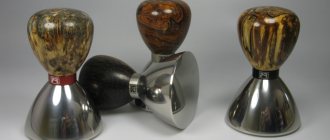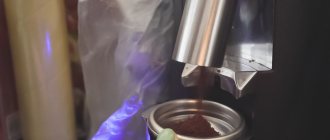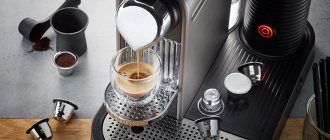April 23, 2015 Varieties and recipes
Oriental coffee is one of the oldest and most accessible methods of making coffee. This drink is prepared in a cezve, over an open small fire or on hot sand. Very often, spices are added to this oriental coffee to taste.
This is one of the most common and accessible coffee recipes today. In various sources, this drink is called differently: Turkish, Arabic, oriental coffee. Thanks to cooking in an open container, you can easily create the drink with as many additives as you like.
Story
The first coffeehouse in the Ottoman Empire was probably built between 1554-1555, and was located near trade and business areas where people of all social classes gathered.
Coffee houses were places to socialize, read, and support the arts. As coffeehouse culture spread, they became thematic and united people by interests - social, political, educational, or simply became a place to exchange information. For example, neighborhood coffee shops were associated with religion and were often located near mosques.
Guild coffee houses were often visited by artisans, where they gathered to socialize and discuss politics. Another variety was minstrel coffee houses; they attracted representatives of the arts, where local and traveling musicians performed songs and ballads. The so-called fire coffee shops were a social area for firefighters; over time, this format was transformed into a 24-hour format - the establishments remained open all night during Ramadan.
Espresso coffee maker
The drink is prepared using steam pressure. This unit can also make cappuccino. To froth milk, you need to place a straw equipped with a nozzle in a container with liquid. Steam will begin to flow through it under pressure. Due to this, foam will appear on the brewed coffee.
The unit works according to this principle:
- the water gradually warms up;
- when the maximum pressure is reached, the valve opens;
- the liquid moves through the tank containing the grains.
Depending on the device model, you can prepare 2-4 cups at a time. Designs that create a pressure of 15 bar are more advanced than those designed for only 3.5-5 bar. In them, the liquid absorbs a maximum of aromatic substances.
For this type of coffee maker, it is recommended to use a special type of product. It's called espresso. These are coarsely crushed grains that have undergone special heat treatment.
Oriental coffee
Oriental coffee is the name given to the unique way of preparing the drink, which distinguishes it from others. According to the recipe, it is brewed in copper coffee pots - cezves (Turks) - over low heat. This ancient method was discovered in the Ottoman Empire.
The traditional type of cezve, by the way, has not changed significantly over time. It has a long handle, making it easier to hold over the fire, a large enough base to make the most of the heat from the fire, and a narrow neck so that no drops spill past the cup.
Oriental coffee utensils are an important part of tradition
Short description
The idea of using coffee beans to make an invigorating drink originated in the East. Therefore, the first recipes were created by Arabs, Ethiopians, Yemenis, etc., who still prepare incomparable espresso. In Russia, the oriental recipe appeared during the reign of Alexei Mikhailovich, when trade relations with Turkey were well developed.
The drink also has another name – Turkish coffee. It is traditionally prepared in the Middle East, Caucasus, Africa and Balkan countries. Although each of these places adds its own ingredients to the classic recipe, they all share a common cooking technology.
According to ancient traditions, the oriental drink is prepared in a pot over an open fire or hot sand. This process can take from 10 minutes to 2 hours. Unfortunately, an automatic coffee machine is not suitable for creating such a drink.
What affects the taste of coffee
Roasting
The roasting process is called one of the most important factors affecting the taste of coffee.
There are three main designations for the degree of roasting. The lightest has more “untouched” fresh and bright taste, aroma and sourness. The darkest color will give the drink a bitter taste. And the middle one combines the nuances of chocolate and caramel flavors, and combined with citrus notes - the golden mean for those who love balance.
Grinding
For many years, a press and mortar were used to grind coffee beans. Then hand mills came into use. Today, fortunately, their place has been taken by electronic coffee grinders - grinders.
To prepare Turkish coffee, ultra-fine grinding is usually used - its particles make the drink thicker, denser and velvety. It is almost impossible to grind beans yourself, so you should give preference to store-bought ground coffee.
Another important point is the uniformity of particles. If they are significantly different in size, then the taste will be distributed unevenly, some will brew much faster, some slower, and it will be almost impossible to predict how the coffee will taste.
Rules for serving and consumption
Coffee is served in small cups, the grounds are not drained. To speed up the sediment, you can add a couple of drops of cold water to the cup. You should drink oriental coffee in small sips, washing it down with cold water, which makes it possible to fully appreciate the aroma and taste of the drink.
When serving, certain rules are followed: foam is poured into the cups first, after which the drink itself is poured. Sugar, spices and spoons are not served as all the necessary ingredients are added during cooking. The cups themselves can be thick-walled ceramic or special thin-walled glass, which maintain the temperature of the drink for a long time.
To serve, you can use special sets that include a Turk, a cup and a saucer, made in the same style. They are placed on a small tray, with a glass of water placed on the left. When serving, you can carefully collect the coffee foam with a spoon, pour the drink into cups, and then carefully place the collected foam on top.
Ground VS grain
Many people believe that coffee beans are more aromatic and richer than ground coffee because they grind it immediately before preparation. But in fact, their main difference is only in the method of storage. The fact is that ground coffee can be every bit as flavorful if kept in the right conditions. Modern technologies help us. Vacuum allows you to preserve all the qualities of coffee, tightness is the main ally of ground coffee, since modern packaging does not allow coffee powder to come into contact with air.
In addition, ground coffee saves you time and energy; the risk of making a mistake when brewing (and making it too strong, for example) is much lower than when grinding and brewing coffee beans.
Coffee grinding requirements
To make the drink truly tasty, aromatic and correct, it is very important to follow the rules for choosing the main ingredient:
- the quality of the beans must be the highest - you can choose both high-quality Arabica beans and blends of flavors;
- The grinding of the beans should be fine - this results in a thick, aromatic and tasty drink;
- It is better to grind the grains in a special machine, since ordinary coffee grinders do not give the desired result - the fractions are not very fine;
- It is better to take purified, soft water without any metal impurities.
How to choose ground coffee for Turkish
First, you need to decide on the type of coffee that you are going to brew in the Turk. And we advise you to choose Arabica. When oriental coffee appeared, it was brewed with Arabica coffee for many decades, using expensive and high-quality varieties.
Unlike Arabica, Robusta is bitter, smells less pleasant (and the aroma is also part of the magical mystery of making coffee), and gives more strength.
There are many different options in the Arabica category. You shouldn’t chase the most expensive one on the store shelf; it’s better to look at the composition, because there are no guarantees that the more expensive one will have the best composition.
When choosing, pay attention to the roasting – it is usually indicated on the packaging. Roasting too dark can be bitter, while light roasting can be sour. At the same time, the copper cezve can slightly change the shades of flavors - the bitterness will become stronger, and the sourness will be slightly leveled out.
How to drink correctly
The drink is poured directly at the table into small cups. However, it is not filtered. To settle the grounds faster, add a couple of drops of water to the cup.
The foam that covers it plays a special role in the drink. It is she who should get into the cup first, and then the drink itself joins it.
There are no additional ceremony supplies. There is no need for them, since everything necessary was put in during cooking.
The drink should be consumed from especially small cups. Using tea cups or espresso utensils for drinking is considered bad manners.
How to make Turkish coffee at home
To make oriental coffee, take a copper pot, fill it with 2/3 of water (about 100 g), and place it on the stove. While the water is heating to 50 degrees, measure out the coffee. The water to coffee ratio should be 10:1, meaning you only need 10g.
As soon as the water warms up to 50 degrees, pour coffee into it, stir and leave to simmer over low heat for 3 minutes. During this time, the liquid will heat up to 95 degrees, and the foam will begin to rise, twisting along the walls into the center. Your coffee is ready. Carefully pour it into a warmed cup and enjoy.
Coffee traditions of eastern countries and peoples
Syria
As in many eastern countries, in Syria a cup of coffee is a symbol of hospitality. For a long time, a bride must undergo a “coffee test” before her wedding. According to tradition, a girl must know how to make good coffee. In order to find out the abilities of her future daughter-in-law, the groom's mother comes to visit.
The bride asks everyone present at the ceremony what kind of coffee they would like. After this, she must prepare a drink from the best water and perfect grains. Serving cups should be the best you can find in the house. It is important to arrange everything very well, because if the groom’s mother was satisfied with the reception, most likely, her consent to the marriage has been received.
Abyssinia
In Abyssinia, the drink was prepared like this: the grains were roasted over coals, then ground in a wooden mortar. The ground grains were boiled in a special vessel - jebene. The vessel had to have a narrow clay neck and have increased heat resistance so that it could be placed directly on the fire. During preparation, the drink could be sprinkled with incense or gum arabic to add flavor. When the drink was ready, the owner distributed it into cups. It is curious that some volume of liquid was sure to spill onto the ground. But no one grieved about this, because it was also part of the coffee tradition.
Yemen
In Yemen, coffee was made in this way: the beans were roasted (without removing the shell), then crushed in a mortar. A special vessel was needed for cooking. The drink had to be brought to a boil twice and then served. They preferred to drink it very concentrated and strong. If desired, they were seasoned with ginger, and dates were sometimes served with the drink. Sugar, as a rule, was not added.
Lifehacks and barista secrets
The lifehacks and barista secrets below will help you make coffee faster, tastier and more economically. Some things are obvious, others are not so easy to guess.
1. During free time from work, pitchers should be stored in the refrigerator, then the milk in them will be better frothed. If the pitcher remains hot after preparing the drink, you can add cold milk to it and immediately put it in the refrigerator.
2. Glasses, on the contrary, should be as hot as possible. Of course, except when making iced coffee or milkshakes. It is convenient to place one glass of each size at the front edge of the coffee machine, so they will heat up quickly and will be more convenient to take.
3. If you work on a two-group coffee machine, and the flow of people is not very large, it is optimal to use only one group, then you won’t have to wash the second in the evening.
4. Holders (horns) must always be inserted into the group and be warmed up. Before grinding the beans, the holder should be wiped with a napkin to cool it slightly and prevent the coffee from burning.
5. It is better to add syrups and sugar to the glass rather than to the milk before whipping. Then the milk from the pitcher will not have to be poured out after preparing the drink. In this case, the drink must be stirred.
6. But it is better to add sour (berry) syrups to cold milk, this will prevent the drink from curdling when whipped.
7. The barista should have a clean toothpick on hand; it will help make a beautiful design on the coffee, even if the traditional heart when pouring milk was not successful.
8. It is advisable to check with the buyer how sweet the drink is needed and add sugar yourself, quickly stirring with a spoon. This will help preserve the stirrers and speed up the queue.
9. You can prepare two small cappuccinos at the same time using a double holder, this is faster than filling a single one twice.
10. If you make an additional hole in a milk carton with a knife or scissors, the milk will flow smoothly and without splashing.
11. To wipe the holders, it is enough to use only two or three napkins a day, if you have a special container for napkins near the area where the coffee is shaken out. It is economical and environmentally friendly.
12. Cupholders are usually worn for particularly hot drinks: Americano and tea. A standard cappuccino, even in a single-layer glass, should not burn your hand.
13. If you charge customers only after preparing the drink, the likelihood of purchasing related products increases.
14. Baristas usually have lunch close to their workplace. If you don’t have a microwave, you can heat your food using a coffee machine. The food will heat up in about an hour.
15. A regular paint brush or any brush will work great for brushing coffee off the temping mat and coffee grinder stand.
16. On all opened packages, except standard milk and cream, the date of opening must be written in order to control the expiration date. This is not only a life hack, but also a requirement of Rospotrebnadzor.
17. If the guest ordered espresso, it is recommended to also serve a glass of clean water. Water will help cleanse your taste buds before drinking the drink.
If you know more life hacks and secrets that baristas use, feel free to write them in the comments. (to open the link from the turbo page you need to go to the full version)
A few simple tips
Finally, I would like to give a few tips that will help you brew truly delicious coffee. After all, coffee is a kind of art that should be given enough of your time and attention.
To end up with a great drink:
- It is better to add sugar to a heated pot before adding water (many people add sugar to an already brewed drink).
- To get a dense and thick foam, you can warm up the coffee several times (however, make sure that your drink does not boil).
- Cinnamon, ginger, cardamom, cloves, salt and hot pepper will help you find new flavors. However, be careful with additives!
- The cup you plan to pour the coffee into must be preheated. It is enough to pour boiling water into it before starting cooking, and then pour it out just before pouring the drink.
- Make sure that the heat intensity during the cooking process is minimal.
- Let the drink brew before drinking. Literally three minutes is enough. You can even cover the cups with saucers during this time.
Post Views: 16
Experiment with water
98-99% of your cup is water, the rest is dissolved substances from the coffee beans. Therefore water is a very important factor. If the water is soft, the coffee will most likely be overbrewed; if it is hard, it will be underbrewed, so you need to look for the middle. This can be determined by the following signs: undercooked - very watery, without a clearly bright taste; overbrewed - very tart, can turn into bitterness. Good water is water of medium hardness. Here I can recommend either using home reverse osmosis (purification system), or Lipetsk pump room and Volvic water (these are my personal favorites, you can experiment with other brands).
What grains are suitable for the drink?
If it is not possible to bring grains from Arab states, suitable ones can be found on store shelves. There are several varieties on the market. Coffee with spices and cardamom is especially popular. The drink comes out thick and rich.
Europeans prefer ground coffee, which contains 10% cardamom. The taste of this drink is soft and gentle. In addition to its special smell, cardamom imbues the drink with beneficial qualities. This product is considered one of the best aphrodisiacs, thanks to it it relieves lethargy and irritability, stimulates the heart, and cleanses the blood of toxins.
For Arabic coffee, the Mocha mixture is also suitable, which was named after the town of Mokha. It is located on the shores of the Red Sea and is famous for its coffee plantations where high-quality beans are grown. Small, medium and coarse grains are suitable for making the drink. Pulverized coffee is the strongest, it has a rich taste and smell.
Cooking features
You may need to experiment until you find the best way to make coffee in a geyser-type coffee maker. There are several parameters that affect the taste and aroma characteristics and the type of the finished drink.
- Ground coffee – choose a medium or coarse grind. Small or intended for Turkish coffee will not work.
- Cold or hot water - the brewing speed, extraction time, and therefore the taste of espresso depend on the temperature.
- Volume - they come in very different sizes, but it is advisable to choose one that is enough for you at one time. If it's too big, you won't be able to make a small cup.
You can add ground spices directly to the ground coffee.
Step-by-step instruction:
- In any case, before you make coffee in a geyser coffee maker, you disassemble it.
- Take out the filter mesh and pour the crushed grains into it. Do not compact it, otherwise the layer will be too dense and brewing will be complicated. Do not pour it in a heap; on the contrary, it is better to carefully level the top with your fingers or a spoon.
- Pour water into the lower container, no higher than the level of the safety valve.
- Assemble the structure by carefully placing the container with coffee so that it does not spill on the rubber seal. If this happens, remove the excess: with a sponge, brush, or simply blow it away.
- Screw the device in tightly. This is best done by holding the top and bottom, rather than pulling on the handle. Often the handle is the most fragile part and can break.
- Leave the coffee maker to warm up. The heat should be low, so the extraction will go slower, and your espresso will be more intense, aromatic, and thick. If the heat is too high, you can use the handle to hold the coffee maker above the burner, thereby controlling the temperature.
- When the liquid boils away, you will hear a hissing sound. Remove the geyser from the stove and pour the coffee into cups.
At first, you may not close the lid - this will not affect the taste in any way, but you will learn to recognize the sounds of the beginning and end of brewing.
Brewing with cold water
The simplest method that many people use. In this case, cold water, preferably filtered, is poured into the lower container, but it can also be from the tap if it is not too hard or soft. There will be no scale, but this may change the taste of the finished espresso.
Low temperature makes the brewing process longer. At the same time, all parts heat up quickly, including the filter with poured coffee. The coffee burns a little, so the taste is more bitter. Steaming is long, more aromatic and flavor components are revealed, the drink is intense, strong, dense.
If you plan to add milk, we recommend brewing coffee in a geyser coffee maker with chilled water. This will give you a more “coffee” flavor.
Brewing with hot water
For those who love a pure black drink and experiment with the flavors of different varieties. First boil the water and then pour it into the bottom tank. Carefully assemble the device and turn on low heat. Be careful when assembling, the boiling water will heat the metal in a few seconds, so the bottom of the tank will become hot, use a towel or oven mitt.
Boiling will happen very quickly, so the brewing process itself will be shorter. Nothing burns, the espresso turns out soft, there will be no bitterness or “burnt” smell. If you want more intensity, reduce the heat to very low, so the process will take longer.
To brew specialty coffee, it is better to use this method so as not to burn the rather expensive grain and be able to appreciate all its features.
Sweet Neapolitan coffee
In the process of preparing coffee in a geyser coffee maker, you get a beautiful foam, although not very dense. And if you add sugar and stir it, there will be no foam at all. There is a special recipe for cream lovers.
- Pour cold or hot water and put the coffee maker on fire.
- Open the lid so you can see when the spill starts.
- Pour as much sugar into a cup as you need.
- When there is a spill, remove the device and pour some coffee into the cup with sugar.
- Return the device to the fire.
- Using a teaspoon, quickly stir the sugar into the espresso to create something like a viscous syrup with a lot of foam. If there is not enough liquid, add a little more. For one teaspoon of sugar - approximately 2-3 tablespoons of liquid, do not pour too much at once, otherwise you will not be able to whip up the foam.
- When the drink in the geyser is ready, add it to the cup.
- Enjoy the sweet taste and beautiful dense high cream.
The crema foam whips up quite quickly and does not settle, so you can easily make this sweet coffee in 2-3 cups at a time.











